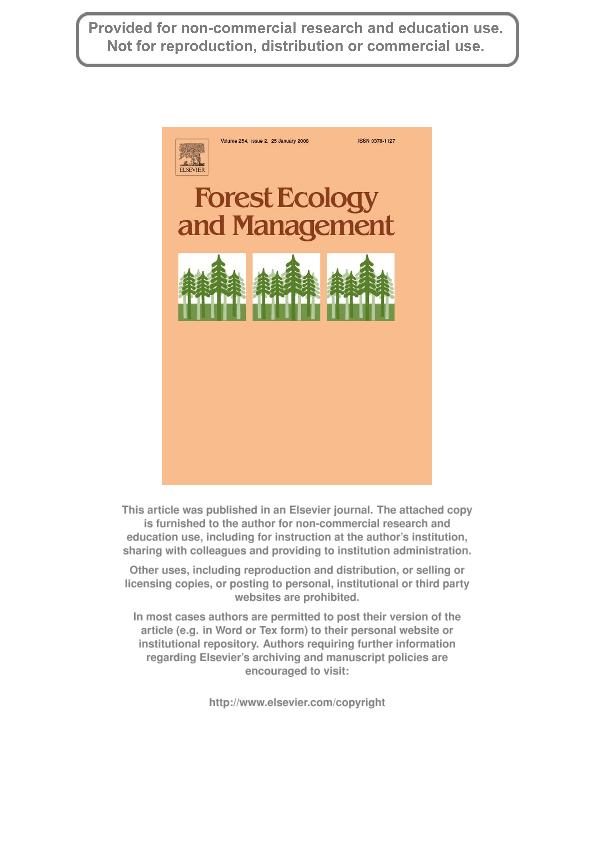Mostrar el registro sencillo del ítem
dc.contributor.author
Torres, Romina Cecilia

dc.contributor.author
Renison, Daniel

dc.contributor.author
Hensen, Isabell
dc.contributor.author
Suarez, Ricardo
dc.contributor.author
Enrico, Lucas

dc.date.available
2017-10-25T12:25:21Z
dc.date.issued
2007-09
dc.identifier.citation
Torres, Romina Cecilia; Renison, Daniel; Hensen, Isabell; Suarez, Ricardo; Enrico, Lucas; Polylepis australis’ regeneration niche in relation to seed dispersal, site characteristics and livestock density; Elsevier Science; Forest Ecology and Management; 254; 2; 9-2007; 255-260
dc.identifier.issn
0378-1127
dc.identifier.uri
http://hdl.handle.net/11336/27042
dc.description.abstract
Polylepis australis (“tabaquillo”) grows in the high mountains of central Argentina, where we set up 76 square study plots of 900 m2. To determine dispersal distance, we distributed 6 seed traps per plot in and around 20 plots. To determine the best site characteristics and livestock stoking rates, at two river basins differing in historic stocking rates, we analyzed the presence of seedlings in 56 plots and recorded topography, vegetation types and indicators of livestock activity. We also measured microsite characteristics in a sample of 32 comparable pairs of 1 m2 quadrats, with and without seedlings. Maximum recorded dispersal distance of P. australis seeds was 6 m, and seedlings were found no more than 10 m from seed trees. The numbers of seedlings and seed trees were 3.5 and 4 times higher, respectively, in the basin with less livestock. At the 900 m2 plot scale, a Poisson regression indicated a positive relationship between seedling number and P. australis canopy cover. At the quadrat scale (1 m2), seedlings were found in quadrats with significantly lower evidence of soil erosion than comparison quadrats without seedlings. We conclude that the main limitations to recruitment are short seed dispersal distances, lack of seed trees and extreme soil erosion. Management should therefore aim at preserving seed trees and reducing livestock density to prevent erosion.
dc.format
application/pdf
dc.language.iso
eng
dc.publisher
Elsevier Science

dc.rights
info:eu-repo/semantics/openAccess
dc.rights.uri
https://creativecommons.org/licenses/by-nc-nd/2.5/ar/
dc.subject
Forest Cover
dc.subject
Erosion
dc.subject
Mesohabitat
dc.subject
Microsite
dc.subject.classification
Bioquímica y Biología Molecular

dc.subject.classification
Ciencias Biológicas

dc.subject.classification
CIENCIAS NATURALES Y EXACTAS

dc.title
Polylepis australis’ regeneration niche in relation to seed dispersal, site characteristics and livestock density
dc.type
info:eu-repo/semantics/article
dc.type
info:ar-repo/semantics/artículo
dc.type
info:eu-repo/semantics/publishedVersion
dc.date.updated
2017-10-18T14:52:41Z
dc.journal.volume
254
dc.journal.number
2
dc.journal.pagination
255-260
dc.journal.pais
Países Bajos

dc.journal.ciudad
Amsterdam
dc.description.fil
Fil: Torres, Romina Cecilia. Universidad Nacional de Córdoba. Facultad de Ciencias Exactas, Físicas y Naturales; Argentina. Consejo Nacional de Investigaciones Científicas y Técnicas; Argentina
dc.description.fil
Fil: Renison, Daniel. Universidad Nacional de Córdoba. Facultad de Ciencias Exactas, Físicas y Naturales; Argentina. Consejo Nacional de Investigaciones Científicas y Técnicas; Argentina. Proyecto Conservación y Reforestación de las Sierras de Córdoba; Argentina
dc.description.fil
Fil: Hensen, Isabell. Martin Luther University Halle-Wittenberg; Alemania
dc.description.fil
Fil: Suarez, Ricardo. Proyecto Conservación y Reforestación de las Sierras de Córdoba; Argentina
dc.description.fil
Fil: Enrico, Lucas. Consejo Nacional de Investigaciones Científicas y Técnicas. Centro Científico Tecnológico Conicet - Córdoba. Instituto Multidisciplinario de Biología Vegetal. Universidad Nacional de Córdoba. Facultad de Ciencias Exactas Físicas y Naturales. Instituto Multidisciplinario de Biología Vegetal; Argentina
dc.journal.title
Forest Ecology and Management

dc.relation.alternativeid
info:eu-repo/semantics/altIdentifier/url/http://www.sciencedirect.com/science/article/pii/S0378112707005853
dc.relation.alternativeid
info:eu-repo/semantics/altIdentifier/doi/https://doi.org/10.1016/j.foreco.2007.08.007
Archivos asociados
